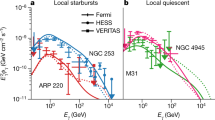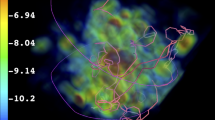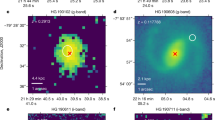Abstract
The origin of the hard (2–10 keV) X-ray background has been a mystery for over 35 years. Most of the soft X-ray background has been resolved into individual sources (mainly quasars), but these sources do not have the spectral energy distribution required to match the spectrum of the X-ray background as a whole. Here we report the results of a deep survey, using the Chandra satellite, in which the detected hard X-ray sources account for at least 75 per cent of the hard X-ray background. The mean X-ray spectral energy distribution of these sources is in good agreement with that of the background. Moreover, most of those hard X-ray sources are associated unambiguously with either the nuclei of otherwise normal bright galaxies, or with optically faint sources. The latter could be active nuclei in dust-enshrouded galaxies or a population of quasars at extremely high redshift.
This is a preview of subscription content, access via your institution
Access options
Subscribe to this journal
Receive 51 print issues and online access
$199.00 per year
only $3.90 per issue
Buy this article
- Purchase on Springer Link
- Instant access to full article PDF
Prices may be subject to local taxes which are calculated during checkout




Similar content being viewed by others
References
Giacconi, R., Gursky, H., Paolini, F. & Rossi, B. Evidence for X-rays from sources outside the solar system. Phys. Rev. Lett. 9, 439–443 (1962).
Mather, J. C. et al. Measurement of the cosmic microwave background spectrum by the COBE FIRAS instrument. Astrophys. J. 420 , 439–444 (1994).
Wright, E. L. et al. Interpretation of the COBE FIRAS CMBR spectrum. Astrophys. J. 420, 450–456 (1994).
Hasinger, G. et al. The ROSAT deep survey. I. X-ray sources in the Lockman field. Astron. Astrophys. 329, 482– 494 (1998).
Schmidt, M. et al. The ROSAT deep survey. II. Optical identification, photometry and spectra of X-ray sources in the Lockman field. Astron. Astrophys. 329, 495–503 (1998).
Ueda, Y. et al. A population of faint galaxies that contribute to the cosmic X-ray background. Nature 391, 866– 868 (1998).
Ueda, Y. et al. Log N-log S relations and spectral properties of sources from the ASCA large sky survey: their implications for the origin of the cosmic X-ray background (CXB). Astrophys. J. 518, 656–671 (1999).
Ueda, Y., Takahashi, T., Ishisaki, Y., Ohashi, T. & Makishima, K. The ASCA medium sensitivity survey (the GIS catalog project): source counts and evidence for emerging population of hard sources. Astrophys. J. 524, L11–L14 (1999).
Cagnoni, I., Della Ceca, R. & Maccacaro, T. A medium survey of the hard X-ray sky with the ASCA gas imaging spectrometer: The (2–10 keV) number counts relationship. Astrophys. J. 493, 54– 61 (1998).
Fiore, F. et al. The contribution of faint AGN to the hard X-ray background. Mon. Not. R. Astron. Soc. 306, L55– L60 (1999).
Weisskopf, M. C. The Chandra X-ray Observatory (CXO): an overview. In Proc. NATO ASI ‘The Neutron Star–Black Hole Connection’ (in the press); also as preprint astro-ph/9912097 at 〈http://xxx.lanl.gov〉 (1999).
Lilly, S. J., Cowie, L. L. & Gardner, J. P. A deep imaging and spectroscopic survey of faint galaxies. Astrophys. J. 369, 79– 105 (1991).
Songaila, A., Cowie, L. L., Hu, E. M. & Gardner, J. P. The Hawaii K band galaxy survey III. Spectroscopy of K < 20 galaxies. Astrophys. J. Suppl. Ser. 94, 461– 515 (1994).
Windhorst, R. A. et al. Identification of faint radio sources with optically luminous interacting disk galaxies. Nature 375, 471 –474 (1995).
Barger, A. J., Cowie, L. L. & Sanders, D. B. Resolving the submillimeter background. Astrophys. J. 518, L5–L8 (1999).
Murdoch, H. S., Crawford, D. F. & Jauncey, D. L. Maximum likelihood estimation of the number-flux density distribution of radio sources in the presence of noise and confusion. Astrophys. J. 183, 1–13 (1973).
Cowie, L. L., Songaila, A., Hu, E. M. & Cohen, J. G. New insight on galaxy formation and evolution from Keck spectroscopy of the Hawaii deep fields. Astron. J. 112, 839–864 (1996).
Wilson, G., Cowie, L. L., Barger, A. J. & Burke, D. J. The evolution of the universal ultraviolet luminosity density with redshift. Astrophys. J. (submitted).
Marshall, F. et al. The diffuse X-ray background spectrum from 3 to 50 keV. Astron. J. 235, 4–10 (1980).
Chen, L.-W., Fabian, A. C. & Gendreau, K. C. ASCA and ROSAT observations of the QSF3 field: the X-ray background in the 0.1–7 keV band. Mon. Not. R. Astron. Soc. 285, 449– 471 (1997).
Gendreau, K. C. et al. ASCA observations of the spectrum of the X-ray background. Publ. Astron. Soc. Jpn 47, L5– L9 (1995).
Miyaji, T. et al. The cosmic X-ray background spectrum observed with ROSAT and ASCA. Astron. Astrophys. 334, L13–L16 (1998).
Ishisaki, Y. et al. Astrophys. J. (submitted).
Vecchi, A., Molendi,, S., Guainazzi, M., Fiore, F. & Parmar, A. N. The BeppoSAX 1-8 keV cosmic background spectrum. Astron. Astrophys. 349, L73–L76 (1999).
Hasinger, G. et al. A deep X-ray survey in the Lockman hole and the soft X-ray log N–log S. Astron. Astrophys. 275, 1–15 (1993).
Almaini, O. et al. A deep ROSAT survey. XII. The X-ray spectra of faint ROSAT sources. Mon. Not. R. Astron. Soc. 282, 295–303 (1996).
Setti, G. & Woltjer, L. Active galactic nuclei and the spectrum of the X-ray background. Astron. Astrophys. 224, L21–L23 (1989).
Madau, P., Ghisellini, G. & Fabian, A. C. The unified Seyfert scheme and the origin of the cosmic X-ray background. Mon. Not. R. Astron. Soc. 270, L17–L21 (1994).
Matt, G. & Fabian, A. C. Spectral constraints on Seyfert 2 galaxies as major contributors to the hard (3–100 keV) X-ray background. Mon. Not. R. Astron. Soc. 267, 187–192 (1994).
Comastri, A., Setti, G., Zamorani, G. & Hasinger, G. The contribution of AGNs to the X-ray background. Astron. Astrophys. 296, 1–12 (1995).
Zdziarski, A. A., Johnson, W. N., Done, C., Smith, D. & McNaron-Brown, K. The average X-ray/gamma-ray spectra of Seyfert galaxies from GINGA and OSSE and the origin of the cosmic X-ray background. Astrophys. J. 438, L63– L66 (1995).
Smith, D. A. & Done, C. Unified theories of active galactic nuclei: a hard X-ray sample of Seyfert 2 galaxies. Mon. Not. R. Astron. Soc. 280, 355–377 (1996).
Gilli, R., Risaliti, G. & Salvati, M. Beyond the standard model for the cosmic X-ray background. Astron. Astrophys. 347, 424– 433 (1999).
Schmidt, M., Giacconi, R., Hasinger, G., Trüper, J. & Zamorani, G. The X-ray luminosity function of active galactic nuclei. In Highlights in X-ray Astronomy (Max-Planck Institut für Extraterrestrische Physik report, in the press); also as preprint astro-ph/9908295 at 〈http://xxx.lanl.gov〉 (1999).
Miyaji, T., Hasinger, G. & Schmidt, M. Soft X-ray AGN luminosity function from ROSAT surveys I. Astron. Astrophys. (in the press); also as preprint astro-ph/9910410 at 〈http://xxx.lanl.gov〉 (1999 ).
Moran, E. C., Helfand, D. J., Becker, R. H. & White, R. L. The Einstein two-sigma catalog: silver needles in the X-ray haystack. Astrophys. J. 461, 127–145 (1996).
Allen, S. W., Di Matteo, T. & Fabian, A. C. Hard X-ray emission from elliptical galaxies. Mon. Not. R. Astron. Soc. (in the press); also as preprint astro-ph/9905052 at 〈http://xxx.lanl.gov〉 (1999).
Di Matteo, T. & Allen, S. W. Hard X-ray emission from elliptical galaxies and its contribution to the X-ray background. Astrophys. J. 527, L21–L24 ( 1999).
Haiman, Z. & Loeb, A. X-ray emission from the first quasars. Astrophys. J. 521, L9– L13 (1999).
Hughes, D. H. et al. High-redshift star formation in the Hubble deep field revealed by a submillimetre-wavelength survey. Nature 394, 241–247 (1998).
Barger, A. J. et al. Submillimetre-wavelength detection of dusty star-forming galaxies at high redshift. Nature 394, 248– 251 (1998).
Gunn, K. F. & Shanks, T. Implications of an obscured AGN model for the X-ray background at submillimeter and far-infrared wavelengths. Mon. Not. R. Astron. Soc. (submitted); also as preprint astro-ph/9909089 at 〈http://xxx.lanl.gov〉 (1999).
Piccinotti, G. et al. A complete X-ray sample of the high latitude (|b| > 20°) sky from HEAO 1 A-2: log N–log S and luminosity functions. Astrophys. J. 253, 485– 503 (1982).
Acknowledgements
We thank J. Halpern and G. Hasinger for comments which improved the first draft of this Article; we also thank the CXC, L. Van Speybroeck, M. Weisskopf and the MSFC team, M. Bautz, G. Garmire, and the ACIS team for building and operating the observatory. We acknowledge the use of HEASARC software. A.J.B. was supported by the Hubble and Chandra fellowship programs.
Author information
Authors and Affiliations
Corresponding author
Rights and permissions
About this article
Cite this article
Mushotzky, R., Cowie, L., Barger, A. et al. Resolving the extragalactic hard X-ray background. Nature 404, 459–464 (2000). https://doi.org/10.1038/35006564
Received:
Accepted:
Issue Date:
DOI: https://doi.org/10.1038/35006564
This article is cited by
-
The Chandra X-ray galaxy clusters at z<1.4: constraints on the evolution of L X −T−M g relations
Astrophysics and Space Science (2014)
-
Active galactic nuclei — the physics of individual sources and the cosmic history of formation and evolution
Frontiers of Physics (2013)
-
DXL: a sounding rocket mission for the study of solar wind charge exchange and local hot bubble X-ray emission
Experimental Astronomy (2011)
-
A black hole in a globular cluster
Nature (2007)
-
Falsificationism Falsified
Foundations of Science (2006)
Comments
By submitting a comment you agree to abide by our Terms and Community Guidelines. If you find something abusive or that does not comply with our terms or guidelines please flag it as inappropriate.



